
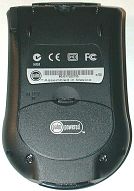
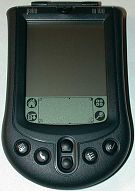
Size wise, the m100 can't really be compared to the Palm V series. The m100 is actually the thickest Palm OS device yet. Check the stack up pictures below. Top to bottom: m100, Palm V, Handspring Visor, Palm IIIc.
| Official
Gadgeteer Hands On Review: Palm m100 by Julie Strietelmeier Last date revised: 08/27/2000 |
Product Requirements:
Desktop:
Windows 98/95 or NT 4.0, 8mb RAM minimum, One available serial port,
CD-ROM drive
Macintosh Machines: PowerPC Processor, System 7.5.3 or higher
The latest offering from Palm Computing is the
m100. As in the past, this new device doesn't have any major improvements, or compelling new features. Basically, it's a Palm IIIe in a new casing. As a matter of fact, the
m100 is the replacement for the Palm IIIe.
Hardware Specs:
Processor: Motorola EZ Dragonball 16mhz
Operating System: Palm OS 3.5
Memory: 2MB RAM
Display: 160x160 pixel, 16 gray scale LCD
Power: 2 AAA Batteries
Communications: Serial and IR port
Size and weight: 4.66 x 3.12 x 0.72in (11.84 x 7.92 x 1.83cm), 4.4 oz (124.7g)
My first impression upon seeing the m100 was that it looked like a toy. It has a more kiddish look to it than the corporate style of previous Palm OS devices. Holding the device, I find that it feels cheaper than my Palm IIIc. By cheaper, I mean that the plastic case tends to flex and creak when I squeeze it as compared to my Palm IIIc or Handspring Visor. The unit is also quite a bit lighter in weight.



Size wise, the m100 can't really be compared to the Palm V series. The m100 is actually the thickest Palm OS device yet. Check the stack up pictures below. Top to bottom: m100, Palm V,
Handspring Visor, Palm IIIc.
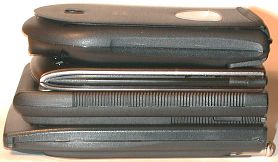
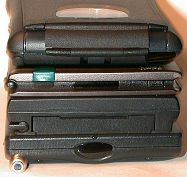
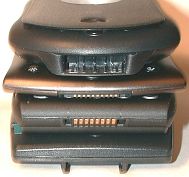
One of the new features on the m100 is the integrated flip cover. This plastic cover can flip all the way around and lay flat on the back of the PDA. It also has a small window that allows you to see the time and date when pressing the up hardware scroll button. This button is accessed thru an opening at the bottom of the flip cover. When you press the button, the
m100 powers on and the time and date are displayed for about 3 seconds and then the unit powers off again. One bad thing about the cover is that there is no latch to hold it closed. It just lays there. If you turn the unit upside down, the cover will flop open. The cover can be removed if desired.
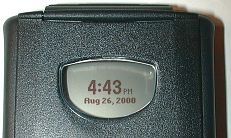
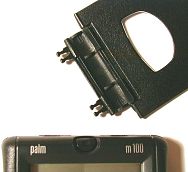

Besides the removable flip cover, you can also remove the entire face plate. Just like the Nokia cell phones, there will be different color face plates available for purchase thru the Palm.com website.
The m100 has the same familiar application button layout as previous models. There are 4 application buttons, and the up/down scroll buttons. Fortunately, the up/down scroll buttons are separate and large. If you like to play games, having separate buttons is a real help. The application buttons are dome shaped instead of concave like the Palm IIIc. They also have good tactile feedback when pressing them. The same goes for the up/down scroll buttons. Now the power button is another story. For some reason they decided to locate this button to the top center of the unit. The button is nice and large, but I find its location to be less than convenient. The button is also very stiff and requires a firm press to turn the unit on. I'm always having to press the button twice to get it to activate. This tends to irritate me so I usually use one of the application buttons to power the unit on instead.
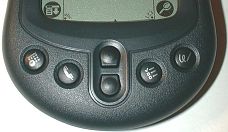

The LCD display on the m100 is different from previous models. The display is smaller,
and plastic instead of glass. This new display is
noticeably smaller. In my opinion, it is almost too small. I prefer a larger screen. That said, the new display is super crisp and clear. I think it looks better than my
Handspring Visor but I still prefer the Palm V screen over it. The display is still only 160 x 160 pixels, but the DPI is tighter which makes it seem like it has a higher resolution.
| m100 | Palm III / IIIx | Palm V | Palm IIIc | |
| IN | 2.675 x 1.965 | 3.20 x 2.375 | 3.075 x 2.242 | 3.15 x 2.33 |
| CM | 6.80 x 5.00 | 8.13 x 6.03 | 7.81 x 5.69 | 8.00 x 5.92 |
| DPI | .29 x .29 | .35 x .35 | - | - |
As I mentioned, the display is also plastic instead of glass. This should help prevent breakage in case of a drop. I know that when I first heard that the display was plastic, my first thought was "Yuck!". But, surprisingly, I can't tell the difference between this screen and any of my other PDA screens. It feels the same writing on it with a stylus. The m100 screen is slick and easy to write on.

On the top left corner of the m100 is the IR port. The port can be used when the flip cover is opened or closed.
Beaming files back and forth to other Palm devices worked great. I was able to
beam a small app to my Palm IIIc from over 7ft away.
The back of the unit has the battery door, reset switch, stylus silo and hotsync port. The stylus silo is easily accessed with the cover is open or closed. The stylus itself is the typical all plastic
variety (no hidden reset pin). It is a bit larger in diameter than previous styli though... which makes it a little more comfortable to use. I do like the stylus clicks into place when you put it in the silo. The hotsync port is less exposed on the
m100 than it is on other Palm OS models. The port wasn't redesigned with a different connector. Instead, it uses the same connectors as the Palm III series. But, because of the rounded casing, the
m100 won't fit in a Palm III series cradle or be able to use Palm III series accessories that connect to the hotsync port. The
m100 doesn't even come with a hotsync cradle (although you can buy one separately). Instead, it comes with a serial hotsync cable. The cable has a
convenient hotsync button that you can press to automate the syncing process. This cable works great with Palm III series PDAs too. I've been using it with my Palm IIIc and it works perfectly. It would have been nice if the cable had been USB or if they would have included both a serial and a USB cable. If you do want USB connectivity, you can purchase the PalmConnect USB kit for $39.95.

The internal speaker on the m100 is quite a bit louder than any Palm OS PDA that I've tested to date. It is clearly
quite a bit louder than my Palm IIIc, and Handspring Visor. It is also just a
bit louder than my Palm V.
The m100 only comes with 2MB of RAM but I've already heard rumors of third parties doing 8 and even
12MB upgrades on this little guy! The processor that the
m100 uses is the same EZ Dragonball 16mhz processor that the Palm V uses. I wanted to test the speed of the
m100 so I used Neal Bridges Benchmark
program to compare my Palm V, Palm IIIc, Visor and m100. I disabled all Hackmaster Hacks prior to the tests.
As you can see, the m100 is just as fast as the Palm V but slower than the Visor
and IIIc.
| Benchmark | |
| m100 | 99% |
| Palm IIIc | 205% |
| Palm V | 99% |
| Visor Deluxe | 158% |
The m100 is powered by 2 AAA batteries. So far, I've noticed that it is doing very well on the original set that came with it. After having the
m100 for over a week now, the battery gauge is still showing 100% full. Although using alkaline batteries might not be as
convenient as in-cradle rechargeable, the m100 looks like it can go a long ways on 2 AAA's.
You can also always buy separate rechargeable batteries and a charger for it if
you desire.
Software-wise, the m100 is pretty much the same as other current Palm devices.
There are two additions and a few things that have been removed. The first addition
is a Note Pad app. This application is linked to the rightmost hardware button. The same button that is linked to the
Memo Pad on other models. The Note Pad app allows you to scribble a note on
the screen instead of using Graffiti. Each note is then time and date stamped.
You can also associate an alarm with the note and file each note in a category.
The Memo Pad app is still available as a separate app. Incase you were thinking
of beaming the new Note Pad app to another Palm OS device, you'll be happy to
know, you can.
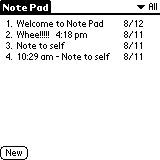

The other addition is the clock app. This is the app that is activated when you press the up button when the unit is off. It is in this app that you now set the time and date (instead of the preferences app). The Clock program will also let you set an alarm with your choose of 6 different alarm sounds (alarm, bumble bee, reveille, sonata, wake up and warbler). This application will not work on other non-m100 devices.
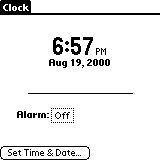
What's missing from the m100? There's no more Mail, or Expense applications. But, if you use these apps and happen to have another palm device, it is possible to beam the apps to the m100 and get them working. Network hotsync has also been removed.
The m100 is a nice device and I do like it but I would be more inclined to recommend the Handspring Visor instead. The Visor is the same price and has the same amount of RAM but, it also has the added expandability of the Springboard slot and has snappier performance. The Visor also has a larger display and more accessories currently available for it. I think that the m100 would be more attractive if it was priced at $100. To me, it feels more like a $100 device than a $150 device.
Price: $149.00
Pros:
Plastic screen won't break as easily
Integrated flip cover
Removable face plates
Loud speaker volume
Cons:
2M of memory
Small screen
| Let me know your comments
on the Palm m100 and read what others have to say. |